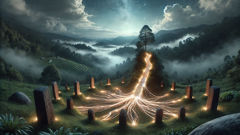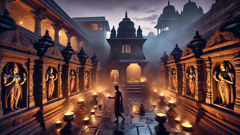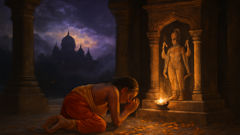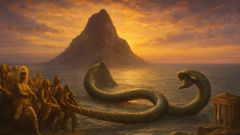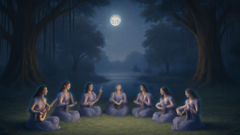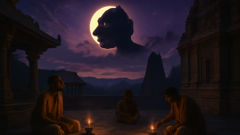Introduction
Long before the world was mapped and charted, before the stories of distant lands met and mingled in the archipelago, there thrived a land called Ibalong. In the heart of what is now the Bicol region of the Philippines, Ibalong flourished—a tapestry of forests, rivers, and volcanic peaks, a place where nature’s beauty was as fierce as its beasts. Here, legends took root in the fertile soil, nurtured by the ancient people’s awe of their wild surroundings and their longing for heroes who could bring order to chaos. Out of these dreams and fears rose the epic poem known as the Ibalong, passed down in a cycle of sixty stanzas—each one a jewel of myth, heroism, and magic. It is a chronicle of the land’s birth, its monsters, and the mortals who dared to challenge fate. The Ibalong’s world is not gentle: colossal boars trample villages, rivers flood with the rage of serpent kings, and darkness creeps from the jungle. Yet, it is a world also brimming with hope, courage, and the relentless will to transform the untamed into a home. The heroes of Ibalong—Baltog, Handyong, Bantong—are not just warriors. They are visionaries who shape the world with their hands and hearts, forging civilization from wilderness. Their battles are not only against beasts of legend but against ignorance, fear, and the very forces of nature itself. To read the Ibalong is to walk with giants beneath the shadow of volcanoes, to hear the clash of spears and the roar of monsters, and to witness the birth of a culture that would echo through centuries. This retelling, woven with vivid imagery and the pulse of ancient verse, invites you to step into a world where myth breathes and heroes never die.
Baltog and the Age of Monsters
When the earth was young and the world unnamed, the land of Ibalong was a wild expanse. Volcanoes rumbled on the horizon, their slopes thick with forests untouched by man. Rivers cut deep through valleys, their currents swollen with the blood of storms. In the shadow of Mount Asog, the forests teemed with creatures beyond imagining—giant boars whose tusks could uproot trees, snakes that slithered like rivers through the undergrowth, and birds of prey as large as houses.
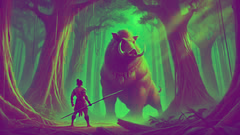
Into this world came Baltog, the first of Ibalong’s heroes. He was a stranger, a traveler from the distant land of Botavara, drawn by stories of a bountiful land. Baltog was tall and broad-shouldered, with eyes that could pierce the darkness and a spear as strong as his resolve. He came seeking a new home for his people, but found instead a land ruled by fear. The villagers lived in terror of Tandayag, a monstrous wild boar said to be invincible. Tandayag’s rampages left villages in ruins, crops trampled, and children orphaned. None dared face the beast—until Baltog arrived.
With his heart steeled by purpose, Baltog listened to the people’s tales of suffering. He studied the trails left by Tandayag: shattered trunks, gouged earth, and the dark stain of destruction. One night, as the moon hung full over the forest, Baltog set out alone, tracking the monster to its lair in the deepest glade. There he waited, silent as stone, hidden among the roots. Hours passed, and at last Tandayag emerged—a beast so huge it seemed a living mountain. Its eyes gleamed red in the moonlight; its tusks shone like polished ivory. Baltog’s breath caught, but his grip did not falter.
When Tandayag charged, the ground shook. Baltog leapt aside, his spear flashing in the night. The battle raged beneath the ancient trees, man and monster locked in a dance of death. Baltog was swift and cunning; Tandayag was raw fury. For hours they fought, the clash echoing through the forest until dawn tinged the sky with gold. At last, with a mighty cry, Baltog struck—his spear driving deep into Tandayag’s heart. The monster collapsed, shaking the earth with its final breath.
Baltog did not celebrate his victory alone. He dragged the beast’s carcass back to the village, a feat so great that none who saw it could doubt his strength. He called the people to witness the end of their terror, and together they rejoiced. Baltog’s courage brought peace to Ibalong, and the people welcomed him as their new leader. He taught them how to clear forests, plant crops, and build homes safe from the wild. Under Baltog’s rule, the age of monsters began to wane—but the land’s trials were far from over.
Handyong and the Dawn of Civilization
Years passed, and Baltog’s name became legend. With the land tamed from monstrous beasts, new challenges surfaced—those of nature and the human heart. Into this evolving world came Handyong, the second great hero of Ibalong. Handyong was wise as he was strong, his mind as sharp as any blade. He was a builder, a dreamer, and a leader who saw not only what was, but what could be.

Handyong gathered the people and spoke of unity. He showed them how to shape tools from stone, weave nets from vines, and craft boats to master the rivers. Under Handyong’s guidance, villages grew into towns, connected by trails and bound by shared purpose. The people learned to cultivate rice, build houses on stilts to withstand floods, and carve out fields from the stubborn earth. The land of Ibalong blossomed—a testament to human ingenuity.
Yet, darkness lingered on the edge of this new dawn. The rivers swelled with rain, and from their depths rose Oryol—a serpent of mythic power. Oryol was cunning and beautiful, her scales shimmering like sunlight on water. She could speak as men did, weaving illusions and beguiling those who listened. At her command, floods swept through villages, fields vanished beneath mud, and terror once more stalked the people.
Handyong faced Oryol not with brute force alone, but with patience and wisdom. He studied her habits, learning when she struck and where she hid. For days he tracked her through tangled mangroves and mist-laden swamps, his followers always close behind. Oryol tried to deceive him with riddles and shapeshifting, but Handyong’s heart was steady.
Their final battle was as much a contest of wills as of strength. Oryol struck from the shadows, her coils swift as lightning. Handyong parried each attack with his spear and shield, never yielding ground. For hours they fought, until at last Oryol faltered—her illusions broken by Handyong’s resolve. With compassion as well as courage, Handyong offered Oryol mercy if she would end her destruction. Awed by his spirit, Oryol relented, retreating into the river’s depths, never to trouble Ibalong again.
Handyong’s victories did not end with monsters. He taught his people laws to guide their lives, music to celebrate their joys, and stories to remember their past. He founded schools, encouraged artisans, and established festivals honoring the gods and the land. Under his rule, Ibalong became a beacon of civilization—a place where harmony blossomed and the seeds of culture took root.
Bantong and the Last Shadows
Time rolled forward like the river’s endless current. The people of Ibalong prospered under Handyong’s rule, but as with every dawn, shadows lingered behind the light. From the farthest reaches of the forests came tales of a new terror: Rabot, a half-man, half-beast whose voice could turn men to stone. Rabot’s presence was felt in the sudden silence of birds, in fields left fallow, and in the fear that crept into people’s hearts after sunset.
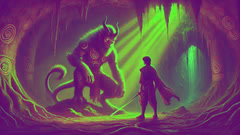
Among Handyong’s most trusted warriors was Bantong—a man renowned not only for his strength but for his cunning and compassion. Bantong was chosen to confront Rabot. Unlike those who had faced monsters before him, Bantong prepared not with force alone, but with careful thought. He listened to the tales of those who had encountered Rabot, piecing together patterns and weaknesses. He learned that Rabot slumbered deeply after a night of terror and that his magic was weakest in the light.
With stealth and patience, Bantong tracked Rabot to his cave at the edge of the world—a dark maw in the side of a hill, shrouded in fog and silence. Armed with only his sword and shield, Bantong waited for the moment when Rabot’s monstrous snores echoed through the air. Moving quietly, he entered the lair. Inside, Rabot lay sprawled on a bed of bones, his body an uneasy fusion of man and beast: human limbs corded with fur, a face twisted by anger and sorrow.
Bantong’s heart quivered at the sight, for Rabot was not only monstrous but pitiable—a creature born of pain and solitude. Yet duty pressed upon him, for as long as Rabot lived, the land would know no peace. With a silent prayer to the ancestors, Bantong raised his sword. In one swift motion, he struck. Rabot’s cries shook the cavern, then faded into silence. The spell lifted from the land; birds sang once more, and light returned to the valleys.
The people of Ibalong celebrated Bantong’s victory not with triumph alone but with mourning for the end of an age. With Rabot’s death, the last of the ancient monsters vanished from Bicol’s forests. Bantong returned as a hero, but also as a witness to change—the knowledge that with every victory comes loss, and that peace is as fragile as the dawn.
Conclusion
The epic of Ibalong lives on in the rivers and volcanoes of Bicol, in the songs and festivals that echo through its villages. Each hero—Baltog, Handyong, Bantong—left more than victory in their wake; they left a blueprint for courage, wisdom, and unity. Their battles against monsters were also battles against chaos, ignorance, and fear. With each triumph, they shaped not only the land but the hearts of those who would call it home. Today, Ibalong is not merely a place but a spirit—a reminder that every age has its monsters and its heroes. The legacy of these ancient legends continues to inspire the people of Bicol and all who hear their stories: to stand brave in the face of darkness, to build when others destroy, and to find hope even in the wildest of lands.



